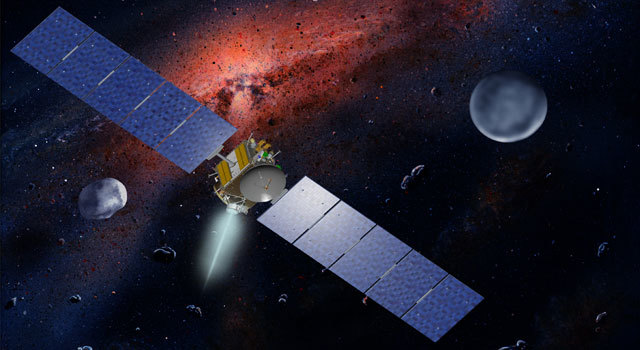News | June 29, 2010
Engineers Assess Dawn's Reaction Wheel

› Larger view
Dawn Mission Status Update
Engineers are studying the reaction wheels on NASA's Dawn spacecraft after automatic sensors detected excess friction building up in one of them and powered it off early on the morning of June 17, 2010. Reaction wheels spin to help a spacecraft maintain attitude control, and Dawn, which is exploring the asteroid belt, uses three wheels in normal operations.
The three other reaction wheels are functioning normally. Mission managers said plans for Dawn to visit the asteroid Vesta in 2011 and 2012 and dwarf planet Ceres in 2015 will not be not affected.
"We're looking at the data carefully in order to understand what the long-term prospects are for this reaction wheel," said Marc Rayman, Dawn's chief engineer, based at NASA's Jet Propulsion Laboratory in Pasadena, Calif. "In the meantime, we're continuing our planned activities with the spacecraft." The spacecraft resumed ion thrusting on schedule, on June 24.
Flight controllers had uploaded software to Dawn's primary flight computer on June 15. As a planned part of that activity, all four reaction wheels had been powered on. Two days later, while the spacecraft was not performing any science or engineering activities, the one reaction wheel built up excess friction. The spacecraft's fault protection system acted as designed and turned the wheel off.
Engineers are analyzing what caused the friction buildup on the reaction wheel. But they do not believe the new software, the reactivation of the spacecraft, or a recent velocity change triggered the reaction wheel issue.
The Dawn mission to Vesta and Ceres is managed by JPL, a division of the California Institute of Technology in Pasadena, for NASA's Science Mission Directorate, Washington. The University of California, Los Angeles, is responsible for overall Dawn mission science. Other scientific partners include Planetary Science Institute, Tucson, Ariz.; Max Planck Institute for Solar System Research, Katlenburg-Lindau, Germany; DLR Institute for Planetary Research, Berlin, Germany; Italian National Institute for Astrophysics, Rome; and the Italian Space Agency, Rome. Orbital Sciences Corporation of Dulles, Va., designed and built the Dawn spacecraft.
To read more about the software update and reaction wheels, see Rayman's Dawn Journal entry for June: http://www.dawn-mission.org/mission/journal_06_27_10.asp .
To learn more about Dawn and its mission to the asteroid belt, visit: http://www.nasa.gov/dawn .


